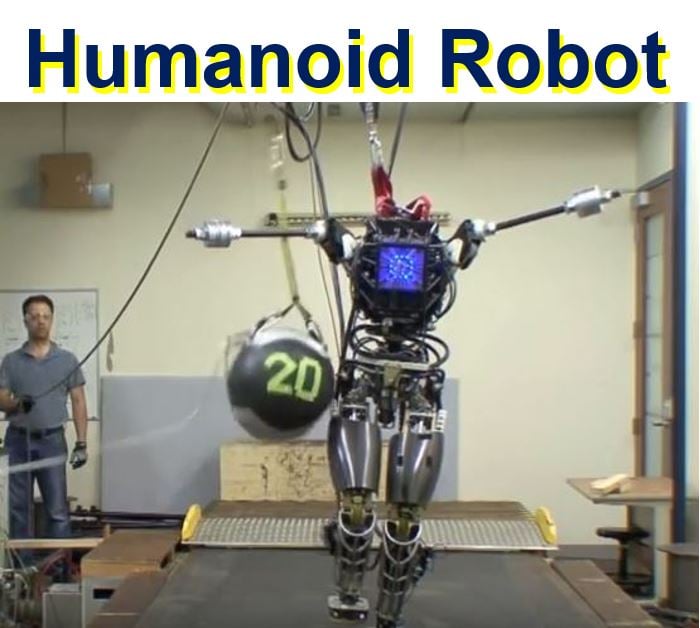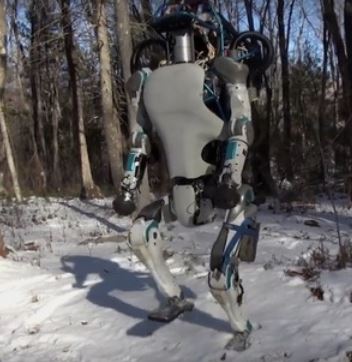An amazing robot called Atlas stays standing up even after a heavy metal ball swings into it. The anthropomorphic (humanoid) robot, which is designed to operate on rough terrain, can be seen in a new video withstanding a beating with ease and also walking on loose rocks with the confidence of a mountain goat.
Atlas can also pick up boxes and place them neatly on shelves, walk in deep snow, and open and close doors by turning the handle – it then walks through the door and closes it afterwards.
If you manage to creep up behind it and push really hard with a pole, it is possible to knock it over. But it gets up incredibly fast, as you can see in the second picture below.
 The engineers swing a heavy weight into Atlas the robot, which stays standing up, totally unfazed by the attack. (Image: Boston Dynamics)
The engineers swing a heavy weight into Atlas the robot, which stays standing up, totally unfazed by the attack. (Image: Boston Dynamics)
Alphabet Inc., a unit of Boston Dynamics, which released the video, says the robot’s balance and control system places the feet strategically and moves the upper body and arms so that it remains upright, no matter what you throw at it or how steeply the ground is tilted.
What is a robot?
The controller uses inertial, kinematic and load data from the robot’s sensors. Atlas is being developed with funding from DARPA’s (Defense Advanced Research Projects Agency’s) M3 programme. DARPA is an agency of the US Department of Defense which is responsible for the development of emerging technologies for use by the military.
Atlas – the all-terrain outdoor humanoid robot
According to Boston Dynamics, an engineering and robotics design company that was acquired by Google X in December 2013, Atlas was designed to negotiate outdoor, rough terrain.
It can walk on two legs, just like a human, leaving its arms free to lift, carry and manipulate the environment. In extremely unfriendly and challenging terrain, Atlas is coordinated and strong enough to climb using its hands and feet, to pick its way through congested spaces.
 An engineer creeps up behind Atlas and pushes hard with a pole, knocking it over. It gets up with incredible precision and ease, almost as if it were an athlete dressed up in a robot costume. (Images: Boston Dynamics)
An engineer creeps up behind Atlas and pushes hard with a pole, knocking it over. It gets up with incredible precision and ease, almost as if it were an athlete dressed up in a robot costume. (Images: Boston Dynamics)
With its articulated, sensate hands, its makers say Atlas will be able to use tools designed for human usage. It includes twenty-eight hydraulically-actuated degrees of freedom, two legs and feet, two arms and hands, and a torso.
Atlas’ articulated sensor head contains a laser range finder and stereo cameras. Unlike its predecessor, which was powered from an off-board, electric power supply through a flexible tether, the new version has no tether and runs off internal batteries. It is about 5-foot-9-inches (1mt 75 cm) tall and weighs 180 pounds (81.6kg).
A disaster recovery robot
Atlas was created to carry out disaster recovery duties in places either humans cannot get to, or that are considered too dangerous for us to venture into, such as damaged nuclear power stations.
It made its debut in 2013 during a DARPA competition. Seven teams of scientists from across the world have been involved with the creation of the new Atlas version, which they say has a better ‘brain’ than its predecessor.
It can climb stairs and other objects, and is also able to avoid debris as well as human soldier.
 When Atlas walks on snow, it manages every step remarkably well, even if it suddenly goes into a deep patch of soft snow, it automatically compensates, adjusts its balance and continues walking at the same speed as if nothing happened. (Image: Boston Dynamics)
When Atlas walks on snow, it manages every step remarkably well, even if it suddenly goes into a deep patch of soft snow, it automatically compensates, adjusts its balance and continues walking at the same speed as if nothing happened. (Image: Boston Dynamics)
Researchers beware
Some might say Boston Dynamic’s engineers need to be careful. If they keep pushing and shoving and swinging heavy weights at it to see what it will do, and at the same time keep upgrading and improving its brain, it could very well turn round one day, look at them and decide judgment day has arrived.
With all its incredible all-terrain walking and amazing climbing skills, escaping from a raging Atlas would be no easy task.
Video – New version of Atlas the robot
This new version of Atlas the robot moves eerily like a human and has an incredible sense of balance, even after heavy weights crash into it.
